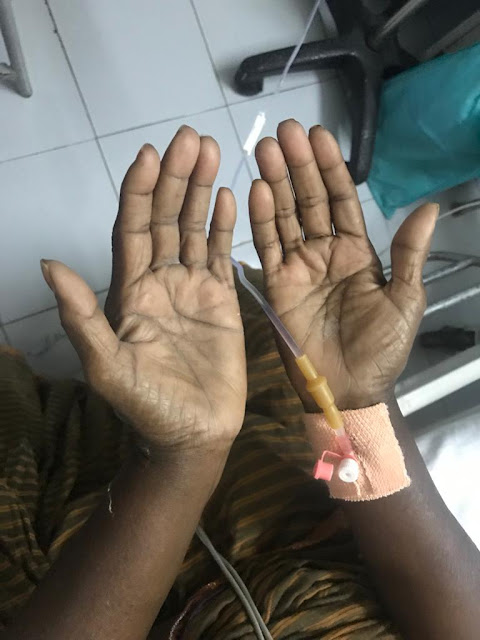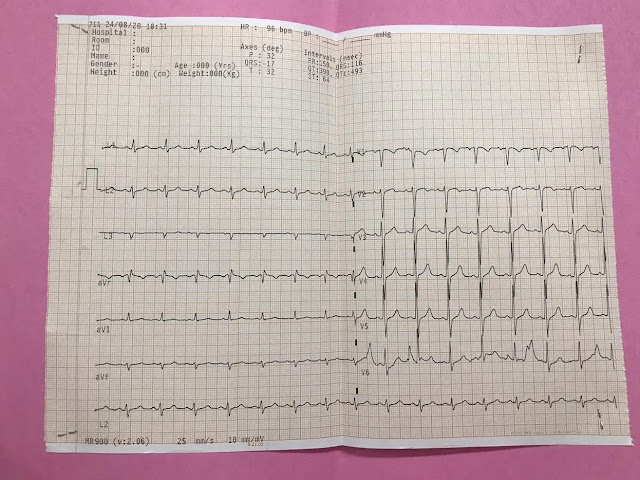Sri Sai Shivani Bhashyam
7/9/2020
Roll No. 129
I have been given these two cases to understand and analyze as part of my End Posting Examination.
Question #1:
1) The complete diagnosis is a 45 year old woman with Nephrotic Syndrome secondary to Diabetic Nephropathy characterized by Anasarca. The anatomical diagnosis is Anasarca and the etiological diagnosis is Nephrotic Syndrome secondary to Diabetic Nephropathy.
2)
- Azotemia is the accumulation of nitrogenous based waste products in the blood. In this case, Azotemia may occur due to acute kidney injury caused by Diabetes. Damage to the glomeruli or renal tubules can lead to decreased glomerular filtration rate which can cause Azotemia.
- Anemia: During her first day in the hospital, a CUE was done which showed 4-5 RBCs/HPF which means there is hematuria to a certain extent. This may be a contributing factor to cause anemia. However, she may be having Iron Deficiency anemia due to kidney injury. Erythropoietin is produced in the peritubular capillary bed of the renal cortex therefore usually Chronic kidney injury decreases Erythropoietin production. Erythropoietin is responsible for producing mature RBCs in the bone marrow or Erythropoiesis and lack of produces anemia.
- Hypoalbuminemia: This occurs to severe proteinuria that can be seen in the CUE. Damage to the basement membrane leads to decreased GFR and proteins are lost in urine therefore decreased serum albumin levels.
- Acidosis: This may occur due to decreased renal ability to excrete acids in her body and decreased bicarbonate reabsorption.
3) Rationale for treatment plan:
Day 1:
Sodium bicarbonate is used to treat metabolic acidosis by increasing plasma bicarbonate levels and pH. It buffers the excess H ions in the blood.
Syrup Potchlor is give to correct Hypokalemia seen in her RFT.
OHAs and antihypertensive drugs are given to control her diabetes and hypertension.
Day 2:
HAI is fast acting therefore it is easier to control her diabetes in a shorter amount of time.
Orofer is an iron and folic acid supplement which is given to treat her iron deficiency anemia.
T. Pan is given to counteract the gastric side effects of these drugs.
Lasix is a diuretic given decrease her anasarca by increasing filtration rate of the loop of Henle therefore decreasing fluid accumulation.
Day 3:
The added drugs:
T. Dytor is also a loop diuretic which has a longer duration of action than Lasix.
T. Telma is Telmisartan which is an Angiotension receptor blocker used to treat Hypertension.
T. Nicardia is Nifidipine which is a calcium channel blocker also used to treat Hypertension but it is more effective.
Erythropoietin is given due to decreased erythropoietin levels.
T. Nodosis is sodium bicarbonate which is given to treat metabolic acidosis. Sodium bicarbonate is given to majority of patients with kidney injury and is effective in nearly all of them. Oral sodium bicarbonate is used as an antacid for mild acidosis and IV sodium bicarbonate is used for severe metabolic acidosis. Sodium bicarbonate is indicated in TCAs, aspirin, and phenobarbitone overdose also.It is contraindicated in metabolic and respiratory alkalosis and hypocalcemia.
T. Shelcal is a calcium supplement since activated calcium is also produced in the kidneys.
4) The indication for dialysis was refractory anuria which is urine output of 0-50ml in 12 hours which was not resolving with diuretics. The crucial factor that led to dialysis is the sudden onset of symptoms: progressive SOB.
5) The other factors that may have led to her condition include stationary lifestyle and chewing tobacco. Since she is a housewife, there is a high probability that she lives a stationary lifestyle which is not advised since she has hypertension. Moderate exercise and a healthy diet is required to control hypertension. She also has been chewing tobacco for 8 years which increases her risk of getting chronic kidney disease by progressive renal failure.
6) The expected outcomes: metabolic acidosis, anemia, anasarca, pain abdomen may be resolved however proteinuria may persist due to any chronic kidney injury.
7) We should evaluate HFpEF again if there are progressive symptoms such as shortness of breath, edema, and proteinuria. It is evaluated through echocardiography where the left ventricular ejection is measured. It is said that " Diagnosis of HFpEF is “a challenge [] as plasma B-type natriuretic peptide levels may not necessarily be elevated, and it may take an exercise stress test to measure filling pressures to diagnose". Therefore it is difficult to detect heart failure in diabetics with renal failure. In a study they said that "28% of patients with diabetes with no history of HF were found to have unrecognized HF, with most of those patients having HFpEF [and]... the prevalence of HF was greater in older adults, women, patients with obesity, dyspnea or hypertension and those who complained of fatigue". Therefore it is very important to control diabetes in this patient.
Reference link: https://www.healio.com/news/cardiology/20190725/treatment-of-hfpef-in-type-2-diabetes-critical-in-improving-outcomes#:~:text=The%20severity%20of%20HFpEF%20is,pressures%20and%20increased%20diabetic%20biomarkers.
8) Placebo would not be very effective since the anemia has an organic cause and her hemoglobin increased from 6.6 mg/dl to 8.5 mg/dl due to Orofer and dialysis over the span of 5 days. The placebo effect will not be seen in this patient because anemia is not the primary cause of her symptoms.
9) CKD-AQ is a very useful tool assess the severity and frequency of symptoms of anemia in CKD however it cannot be translated into Telugu therefore it may not be very useful in this area.
10) Protein energy malnutrition can be seen by progressive Hypoalbuminemia therefore it is very important to prevent protein loss. The subjective global assessment is an excellent to measure whether an individual is properly nourished therefore can be very useful in correcting her Hypoalbuminemia. High protein diet should be given such as egg whites and protein powder in milk.
Question #2:
1) The first case presented with anasarca, anuria with mild hematuria, and abdominal pain with severe proteinuria diagnosed as Nephrotic syndrome and the second case presented with anuria and pain abdomen which was diagnosed as Prerenal AKI. The only drug that varied in treatment was T.Piptaz given in the second case. The expected outcome in the first case is resolution of symptoms but persistent CKD which will require dialysis whilst the second case has a very good expected outcome with resolution of all damage.
2) I don't agree with the provisional diagnosis of Prerenal AKI since there is no hypovolemia so the AKI could be due to post-operative complications of her spine surgery.
3) On ultrasound, the right kidney is larger than the left kidney and there is corticomedullary differentiation. The right kidney is larger due to injury predominantly in the right kidney but there is no sonological abnormality. Therefore this doesn't explain the cause for her renal failure.



Comments
Post a Comment